Midwifery Assignment: Postnatal Depression, Care, and Impact Analysis
VerifiedAdded on 2023/01/11
|6
|1325
|73
Report
AI Summary
This report examines postnatal depression (PND) within the context of midwifery practice, focusing on the experiences of women and babies. It begins with an introduction to PND, defining the condition and highlighting its prevalence based on Australian Bureau of Statistics data. The report then explores the risk factors associated with PND, including the potential for mental illness and the challenges in screening. The role of a student midwife is emphasized, particularly in providing emotional support, conducting patient assessments, and offering evidence-based interventions. A critical appraisal section compares and contrasts epidemiological data on PND across different countries, with a specific focus on Australia and its indigenous population. The report also discusses the impact of socioeconomic factors, lack of maternity education, and the importance of support systems. The conclusion summarizes the key findings and stresses the need for targeted interventions, especially for vulnerable populations. References from the provided assignment are also included, offering a robust framework for the analysis of PND within the context of midwifery practice.
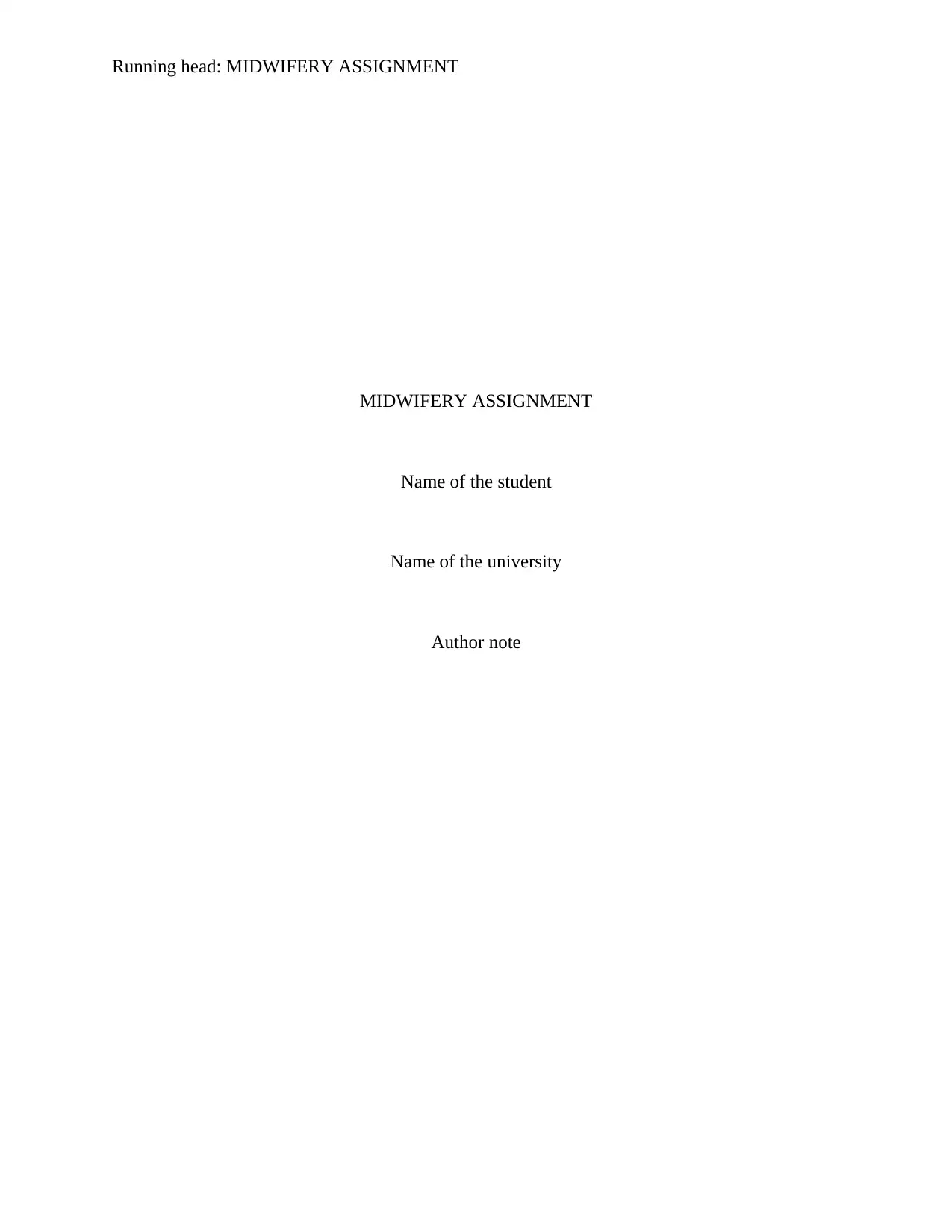
Running head: MIDWIFERY ASSIGNMENT
MIDWIFERY ASSIGNMENT
Name of the student
Name of the university
Author note
MIDWIFERY ASSIGNMENT
Name of the student
Name of the university
Author note
Paraphrase This Document
Need a fresh take? Get an instant paraphrase of this document with our AI Paraphraser
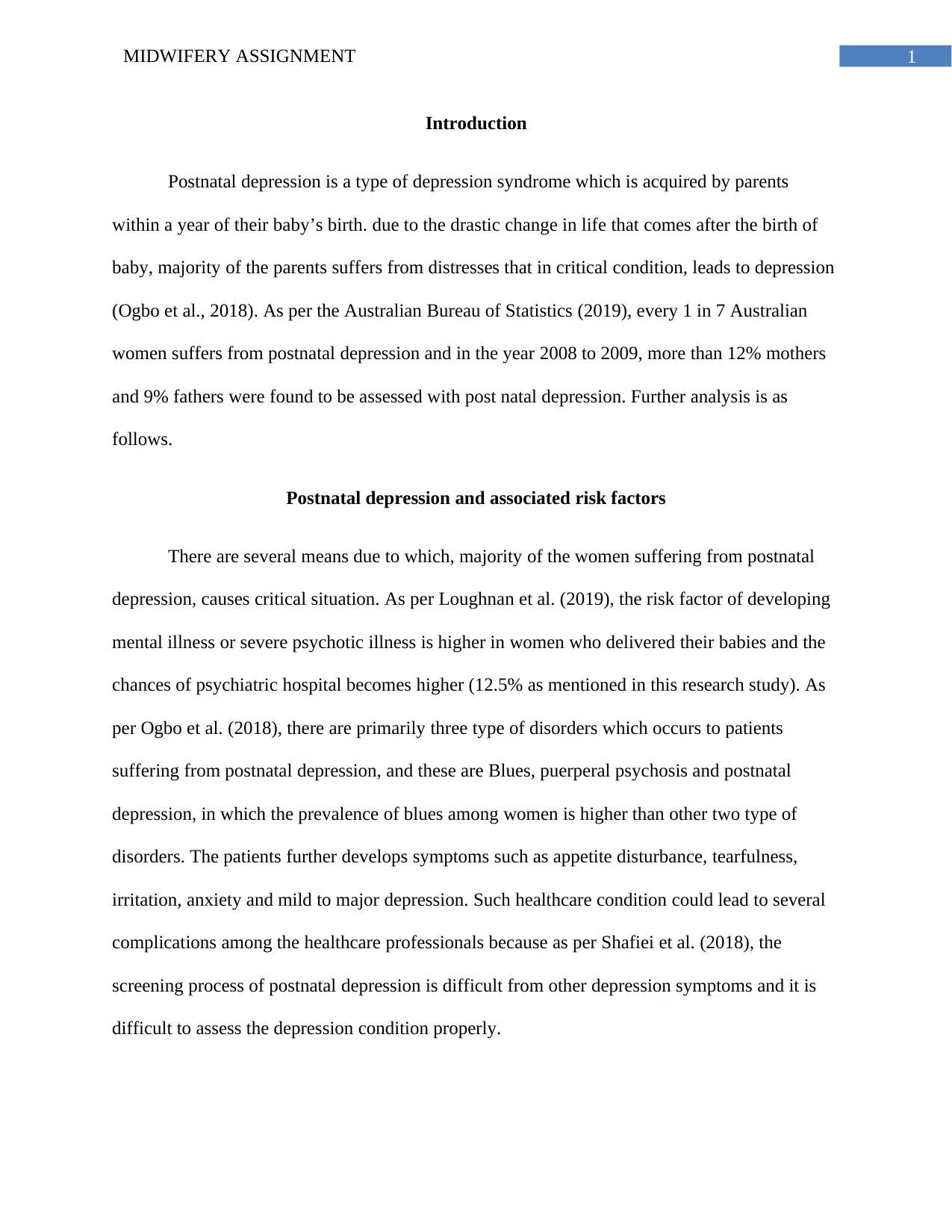
1MIDWIFERY ASSIGNMENT
Introduction
Postnatal depression is a type of depression syndrome which is acquired by parents
within a year of their baby’s birth. due to the drastic change in life that comes after the birth of
baby, majority of the parents suffers from distresses that in critical condition, leads to depression
(Ogbo et al., 2018). As per the Australian Bureau of Statistics (2019), every 1 in 7 Australian
women suffers from postnatal depression and in the year 2008 to 2009, more than 12% mothers
and 9% fathers were found to be assessed with post natal depression. Further analysis is as
follows.
Postnatal depression and associated risk factors
There are several means due to which, majority of the women suffering from postnatal
depression, causes critical situation. As per Loughnan et al. (2019), the risk factor of developing
mental illness or severe psychotic illness is higher in women who delivered their babies and the
chances of psychiatric hospital becomes higher (12.5% as mentioned in this research study). As
per Ogbo et al. (2018), there are primarily three type of disorders which occurs to patients
suffering from postnatal depression, and these are Blues, puerperal psychosis and postnatal
depression, in which the prevalence of blues among women is higher than other two type of
disorders. The patients further develops symptoms such as appetite disturbance, tearfulness,
irritation, anxiety and mild to major depression. Such healthcare condition could lead to several
complications among the healthcare professionals because as per Shafiei et al. (2018), the
screening process of postnatal depression is difficult from other depression symptoms and it is
difficult to assess the depression condition properly.
Introduction
Postnatal depression is a type of depression syndrome which is acquired by parents
within a year of their baby’s birth. due to the drastic change in life that comes after the birth of
baby, majority of the parents suffers from distresses that in critical condition, leads to depression
(Ogbo et al., 2018). As per the Australian Bureau of Statistics (2019), every 1 in 7 Australian
women suffers from postnatal depression and in the year 2008 to 2009, more than 12% mothers
and 9% fathers were found to be assessed with post natal depression. Further analysis is as
follows.
Postnatal depression and associated risk factors
There are several means due to which, majority of the women suffering from postnatal
depression, causes critical situation. As per Loughnan et al. (2019), the risk factor of developing
mental illness or severe psychotic illness is higher in women who delivered their babies and the
chances of psychiatric hospital becomes higher (12.5% as mentioned in this research study). As
per Ogbo et al. (2018), there are primarily three type of disorders which occurs to patients
suffering from postnatal depression, and these are Blues, puerperal psychosis and postnatal
depression, in which the prevalence of blues among women is higher than other two type of
disorders. The patients further develops symptoms such as appetite disturbance, tearfulness,
irritation, anxiety and mild to major depression. Such healthcare condition could lead to several
complications among the healthcare professionals because as per Shafiei et al. (2018), the
screening process of postnatal depression is difficult from other depression symptoms and it is
difficult to assess the depression condition properly.
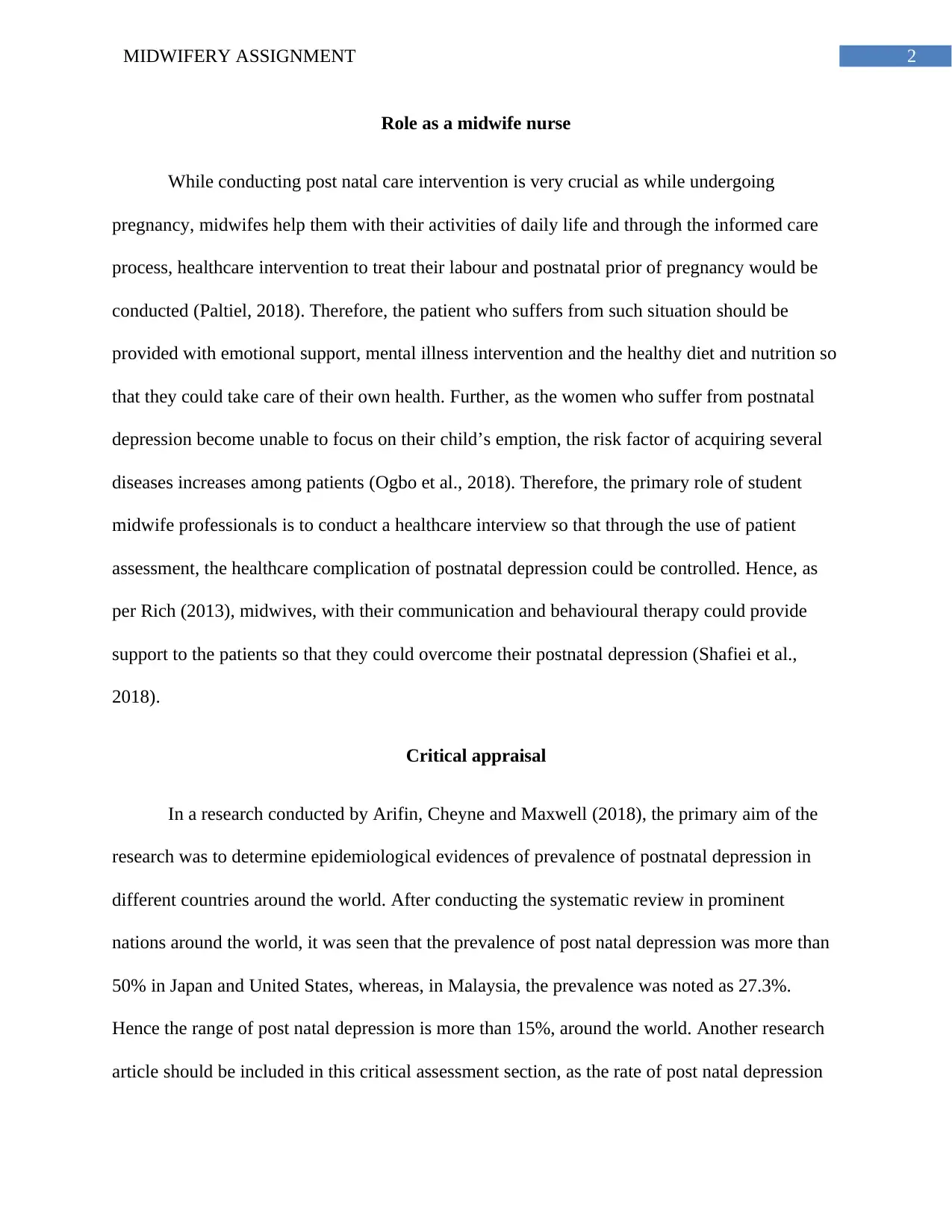
2MIDWIFERY ASSIGNMENT
Role as a midwife nurse
While conducting post natal care intervention is very crucial as while undergoing
pregnancy, midwifes help them with their activities of daily life and through the informed care
process, healthcare intervention to treat their labour and postnatal prior of pregnancy would be
conducted (Paltiel, 2018). Therefore, the patient who suffers from such situation should be
provided with emotional support, mental illness intervention and the healthy diet and nutrition so
that they could take care of their own health. Further, as the women who suffer from postnatal
depression become unable to focus on their child’s emption, the risk factor of acquiring several
diseases increases among patients (Ogbo et al., 2018). Therefore, the primary role of student
midwife professionals is to conduct a healthcare interview so that through the use of patient
assessment, the healthcare complication of postnatal depression could be controlled. Hence, as
per Rich (2013), midwives, with their communication and behavioural therapy could provide
support to the patients so that they could overcome their postnatal depression (Shafiei et al.,
2018).
Critical appraisal
In a research conducted by Arifin, Cheyne and Maxwell (2018), the primary aim of the
research was to determine epidemiological evidences of prevalence of postnatal depression in
different countries around the world. After conducting the systematic review in prominent
nations around the world, it was seen that the prevalence of post natal depression was more than
50% in Japan and United States, whereas, in Malaysia, the prevalence was noted as 27.3%.
Hence the range of post natal depression is more than 15%, around the world. Another research
article should be included in this critical assessment section, as the rate of post natal depression
Role as a midwife nurse
While conducting post natal care intervention is very crucial as while undergoing
pregnancy, midwifes help them with their activities of daily life and through the informed care
process, healthcare intervention to treat their labour and postnatal prior of pregnancy would be
conducted (Paltiel, 2018). Therefore, the patient who suffers from such situation should be
provided with emotional support, mental illness intervention and the healthy diet and nutrition so
that they could take care of their own health. Further, as the women who suffer from postnatal
depression become unable to focus on their child’s emption, the risk factor of acquiring several
diseases increases among patients (Ogbo et al., 2018). Therefore, the primary role of student
midwife professionals is to conduct a healthcare interview so that through the use of patient
assessment, the healthcare complication of postnatal depression could be controlled. Hence, as
per Rich (2013), midwives, with their communication and behavioural therapy could provide
support to the patients so that they could overcome their postnatal depression (Shafiei et al.,
2018).
Critical appraisal
In a research conducted by Arifin, Cheyne and Maxwell (2018), the primary aim of the
research was to determine epidemiological evidences of prevalence of postnatal depression in
different countries around the world. After conducting the systematic review in prominent
nations around the world, it was seen that the prevalence of post natal depression was more than
50% in Japan and United States, whereas, in Malaysia, the prevalence was noted as 27.3%.
Hence the range of post natal depression is more than 15%, around the world. Another research
article should be included in this critical assessment section, as the rate of post natal depression
⊘ This is a preview!⊘
Do you want full access?
Subscribe today to unlock all pages.

Trusted by 1+ million students worldwide
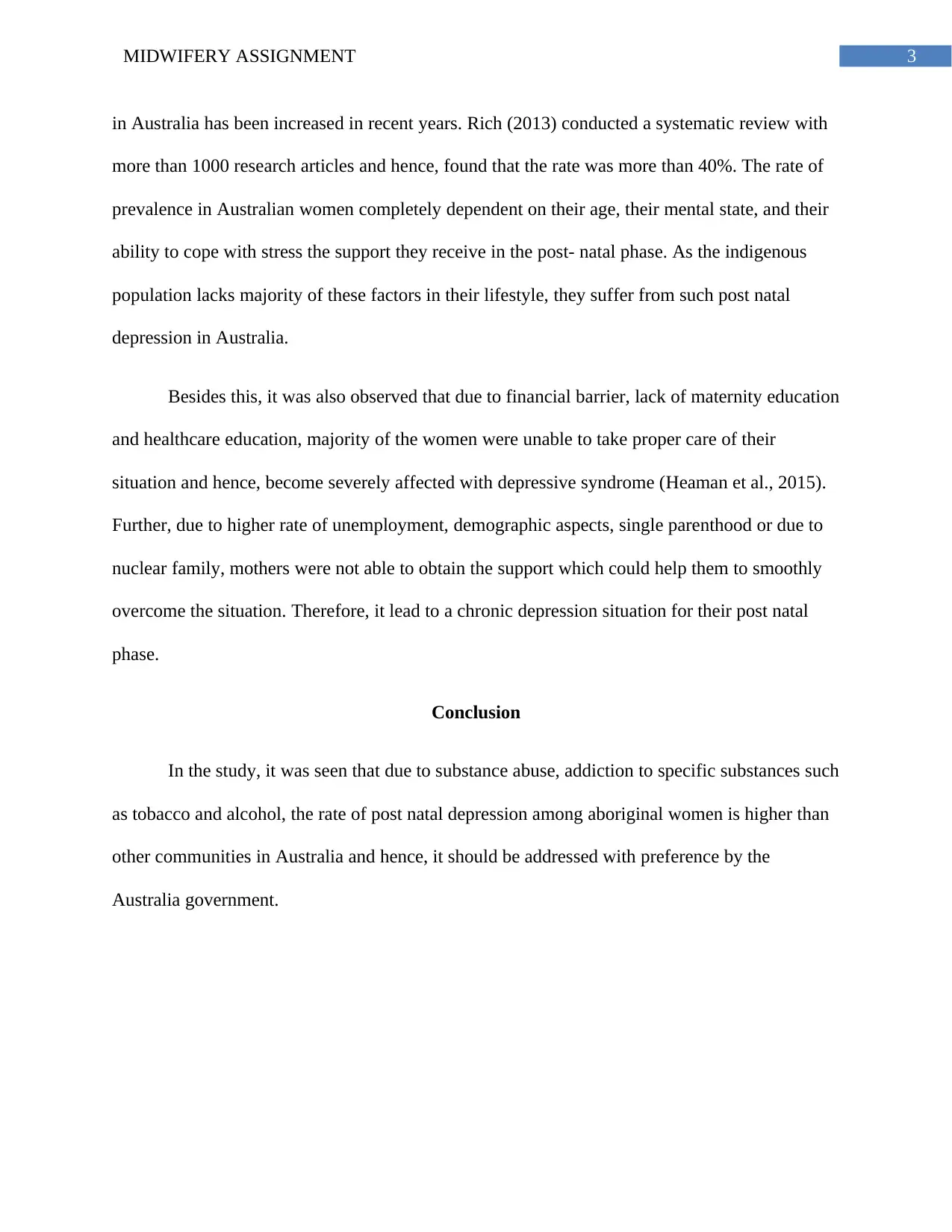
3MIDWIFERY ASSIGNMENT
in Australia has been increased in recent years. Rich (2013) conducted a systematic review with
more than 1000 research articles and hence, found that the rate was more than 40%. The rate of
prevalence in Australian women completely dependent on their age, their mental state, and their
ability to cope with stress the support they receive in the post- natal phase. As the indigenous
population lacks majority of these factors in their lifestyle, they suffer from such post natal
depression in Australia.
Besides this, it was also observed that due to financial barrier, lack of maternity education
and healthcare education, majority of the women were unable to take proper care of their
situation and hence, become severely affected with depressive syndrome (Heaman et al., 2015).
Further, due to higher rate of unemployment, demographic aspects, single parenthood or due to
nuclear family, mothers were not able to obtain the support which could help them to smoothly
overcome the situation. Therefore, it lead to a chronic depression situation for their post natal
phase.
Conclusion
In the study, it was seen that due to substance abuse, addiction to specific substances such
as tobacco and alcohol, the rate of post natal depression among aboriginal women is higher than
other communities in Australia and hence, it should be addressed with preference by the
Australia government.
in Australia has been increased in recent years. Rich (2013) conducted a systematic review with
more than 1000 research articles and hence, found that the rate was more than 40%. The rate of
prevalence in Australian women completely dependent on their age, their mental state, and their
ability to cope with stress the support they receive in the post- natal phase. As the indigenous
population lacks majority of these factors in their lifestyle, they suffer from such post natal
depression in Australia.
Besides this, it was also observed that due to financial barrier, lack of maternity education
and healthcare education, majority of the women were unable to take proper care of their
situation and hence, become severely affected with depressive syndrome (Heaman et al., 2015).
Further, due to higher rate of unemployment, demographic aspects, single parenthood or due to
nuclear family, mothers were not able to obtain the support which could help them to smoothly
overcome the situation. Therefore, it lead to a chronic depression situation for their post natal
phase.
Conclusion
In the study, it was seen that due to substance abuse, addiction to specific substances such
as tobacco and alcohol, the rate of post natal depression among aboriginal women is higher than
other communities in Australia and hence, it should be addressed with preference by the
Australia government.
Paraphrase This Document
Need a fresh take? Get an instant paraphrase of this document with our AI Paraphraser
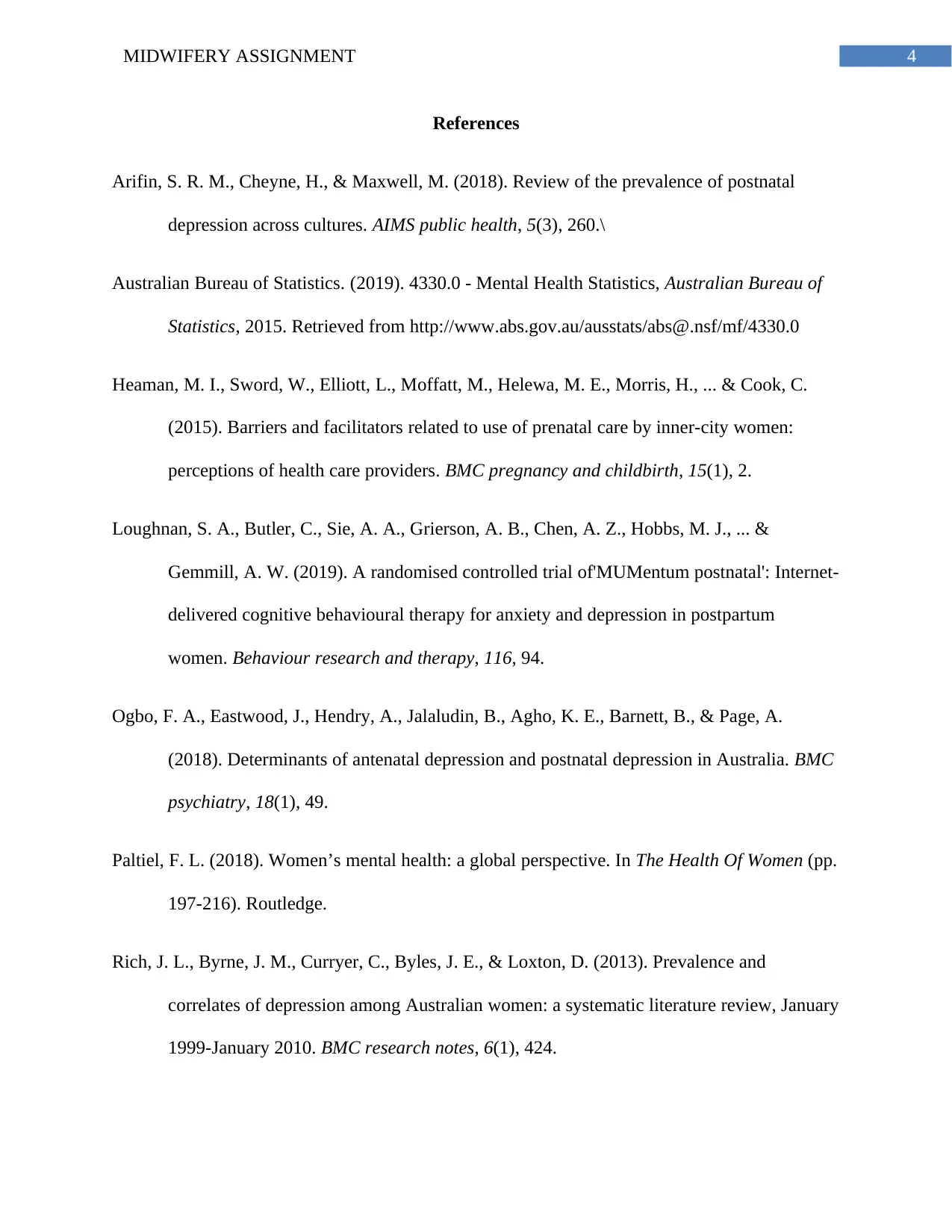
4MIDWIFERY ASSIGNMENT
References
Arifin, S. R. M., Cheyne, H., & Maxwell, M. (2018). Review of the prevalence of postnatal
depression across cultures. AIMS public health, 5(3), 260.\
Australian Bureau of Statistics. (2019). 4330.0 - Mental Health Statistics, Australian Bureau of
Statistics, 2015. Retrieved from http://www.abs.gov.au/ausstats/abs@.nsf/mf/4330.0
Heaman, M. I., Sword, W., Elliott, L., Moffatt, M., Helewa, M. E., Morris, H., ... & Cook, C.
(2015). Barriers and facilitators related to use of prenatal care by inner-city women:
perceptions of health care providers. BMC pregnancy and childbirth, 15(1), 2.
Loughnan, S. A., Butler, C., Sie, A. A., Grierson, A. B., Chen, A. Z., Hobbs, M. J., ... &
Gemmill, A. W. (2019). A randomised controlled trial of'MUMentum postnatal': Internet-
delivered cognitive behavioural therapy for anxiety and depression in postpartum
women. Behaviour research and therapy, 116, 94.
Ogbo, F. A., Eastwood, J., Hendry, A., Jalaludin, B., Agho, K. E., Barnett, B., & Page, A.
(2018). Determinants of antenatal depression and postnatal depression in Australia. BMC
psychiatry, 18(1), 49.
Paltiel, F. L. (2018). Women’s mental health: a global perspective. In The Health Of Women (pp.
197-216). Routledge.
Rich, J. L., Byrne, J. M., Curryer, C., Byles, J. E., & Loxton, D. (2013). Prevalence and
correlates of depression among Australian women: a systematic literature review, January
1999-January 2010. BMC research notes, 6(1), 424.
References
Arifin, S. R. M., Cheyne, H., & Maxwell, M. (2018). Review of the prevalence of postnatal
depression across cultures. AIMS public health, 5(3), 260.\
Australian Bureau of Statistics. (2019). 4330.0 - Mental Health Statistics, Australian Bureau of
Statistics, 2015. Retrieved from http://www.abs.gov.au/ausstats/abs@.nsf/mf/4330.0
Heaman, M. I., Sword, W., Elliott, L., Moffatt, M., Helewa, M. E., Morris, H., ... & Cook, C.
(2015). Barriers and facilitators related to use of prenatal care by inner-city women:
perceptions of health care providers. BMC pregnancy and childbirth, 15(1), 2.
Loughnan, S. A., Butler, C., Sie, A. A., Grierson, A. B., Chen, A. Z., Hobbs, M. J., ... &
Gemmill, A. W. (2019). A randomised controlled trial of'MUMentum postnatal': Internet-
delivered cognitive behavioural therapy for anxiety and depression in postpartum
women. Behaviour research and therapy, 116, 94.
Ogbo, F. A., Eastwood, J., Hendry, A., Jalaludin, B., Agho, K. E., Barnett, B., & Page, A.
(2018). Determinants of antenatal depression and postnatal depression in Australia. BMC
psychiatry, 18(1), 49.
Paltiel, F. L. (2018). Women’s mental health: a global perspective. In The Health Of Women (pp.
197-216). Routledge.
Rich, J. L., Byrne, J. M., Curryer, C., Byles, J. E., & Loxton, D. (2013). Prevalence and
correlates of depression among Australian women: a systematic literature review, January
1999-January 2010. BMC research notes, 6(1), 424.
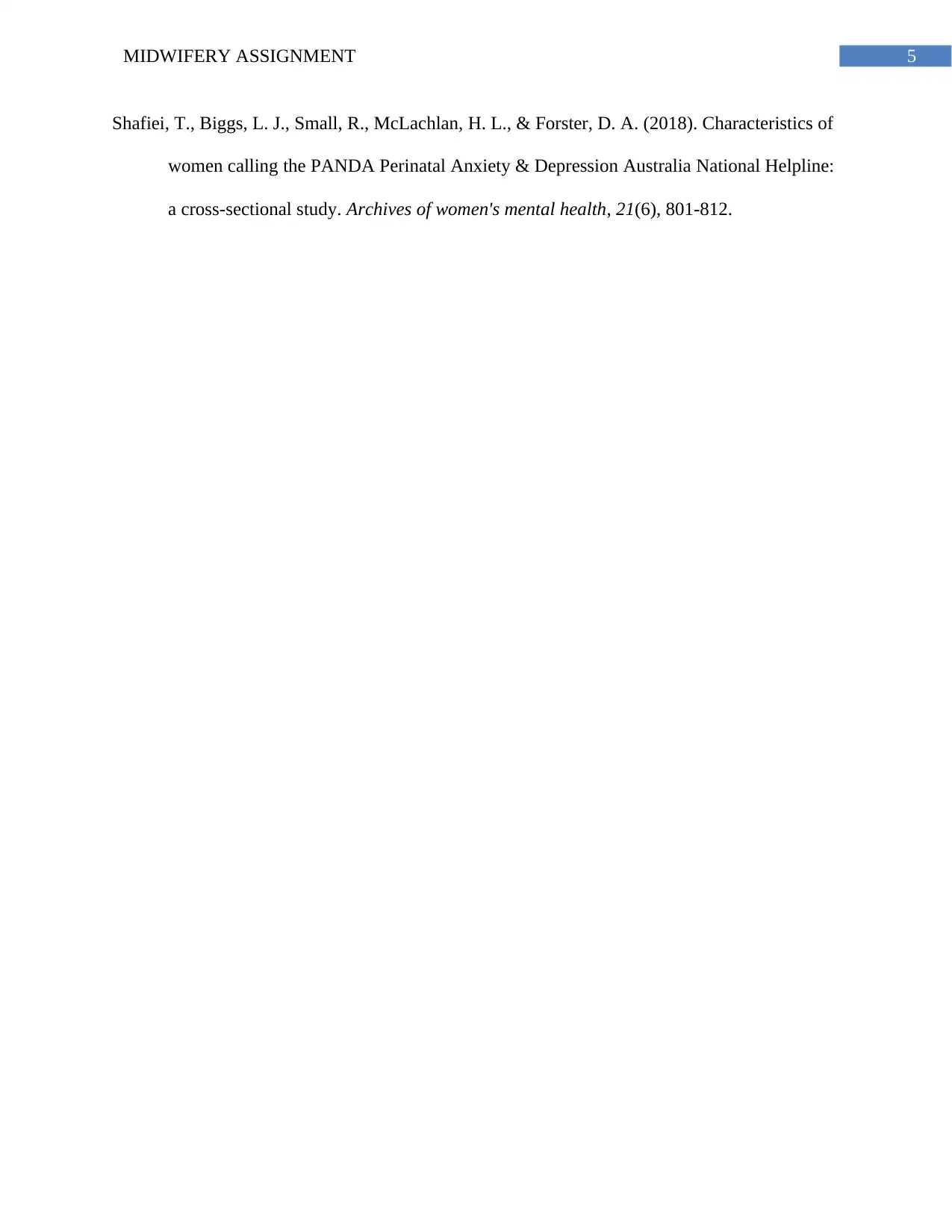
5MIDWIFERY ASSIGNMENT
Shafiei, T., Biggs, L. J., Small, R., McLachlan, H. L., & Forster, D. A. (2018). Characteristics of
women calling the PANDA Perinatal Anxiety & Depression Australia National Helpline:
a cross-sectional study. Archives of women's mental health, 21(6), 801-812.
Shafiei, T., Biggs, L. J., Small, R., McLachlan, H. L., & Forster, D. A. (2018). Characteristics of
women calling the PANDA Perinatal Anxiety & Depression Australia National Helpline:
a cross-sectional study. Archives of women's mental health, 21(6), 801-812.
⊘ This is a preview!⊘
Do you want full access?
Subscribe today to unlock all pages.

Trusted by 1+ million students worldwide
1 out of 6
Related Documents
Your All-in-One AI-Powered Toolkit for Academic Success.
+13062052269
info@desklib.com
Available 24*7 on WhatsApp / Email
![[object Object]](/_next/static/media/star-bottom.7253800d.svg)
Unlock your academic potential
Copyright © 2020–2025 A2Z Services. All Rights Reserved. Developed and managed by ZUCOL.





